22 August Maria Regina, the story of Mary's royalty

Pope Pius XII instituted this feast in 1954. But Mary's royalty has roots in Scripture. At the Annunciation, Gabriel announced that the Son of Mary would receive the throne of David and would reign forever. At the Visitation, Elizabeth calls Mary "mother of my Lord". As in all the mysteries of Mary's life, she is closely associated with Jesus: her kingship is a participation in the kingship of Jesus. We can also remember that in the Old Testament the king's mother has a great influence at court.
In the XNUMXth century Saint Ephrem called Mary "Lady" and "Queen". Later, fathers and doctors of the Church continued to use the title. The hymns of the XNUMXth-XNUMXth century address Mary as queen: “Ave, Regina Santa”, “Ave, Regina del cielo”, “Regina del cielo”. The Dominican rosary and the Franciscan crown, as well as numerous invocations in the litanies of Mary, celebrate her royalty.
The feast is a logical follow-up to the Assumption, and the octave of that feast is now celebrated. In his 1954 encyclical To the Queen of Heaven, Pius XII emphasizes that Mary deserves the title because she is the Mother of God, because she is closely associated like the New Eve with the redemptive work of Jesus, for her preeminent perfection, and for her power of intercession.
Reflection
As St. Paul suggests in Romans 8: 28-30, God predestined humans from eternity to share the image of his Son. Especially since Mary was predestined to be the mother of Jesus. Since Jesus was to be the king of all creation, Mary, dependent on Jesus, was to be the queen. All other titles of kingship stem from this eternal intention of God. Just as Jesus exercised his kingdom on earth by serving his Father and his fellow men, so Mary exercised his kingship. As the glorified Jesus remains with us as our king until the end of time (Matthew 28:20), so does Mary, who was taken up into heaven and crowned queen of heaven and earth.